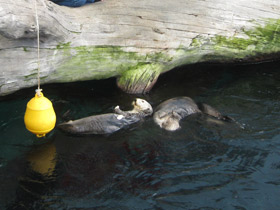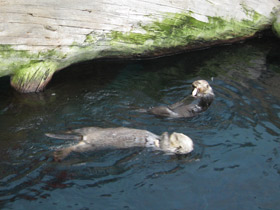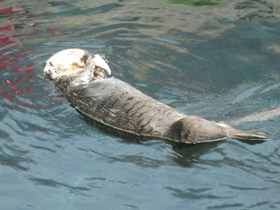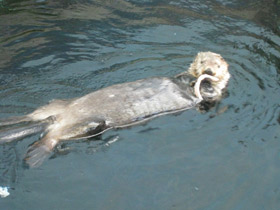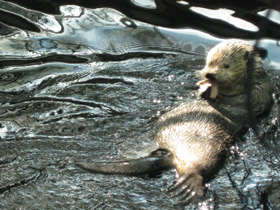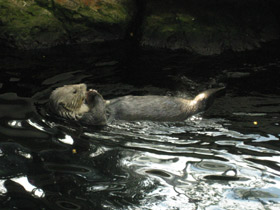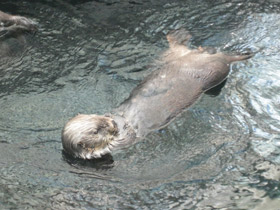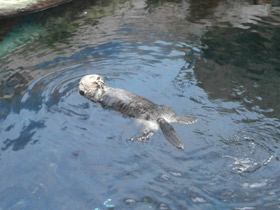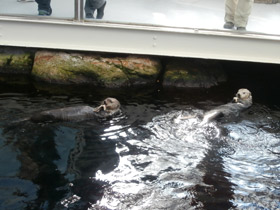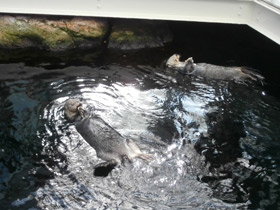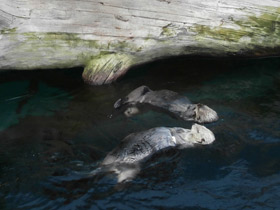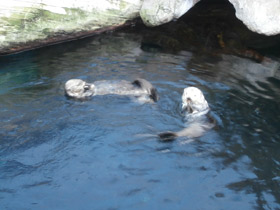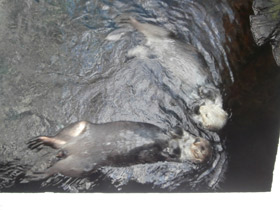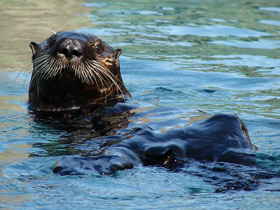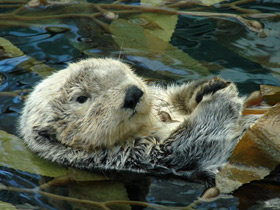The sea otter (Enhydra lutris)
 The sea otter (Enhydra lutris) is on the Russian Red List
The sea otter (Enhydra lutris) is on the Russian Red List
 The sea otter (Enhydra lutris) is included in the IUCN Red List as an "endangered species"
The sea otter (Enhydra lutris) is included in the IUCN Red List as an "endangered species"
The sea otter (Enhydra lutris) is a marine mammal native to the coasts of the northern and eastern North Pacific Ocean.
Appearance and peculiarities
Enhydra lutris is a species of carnivorous mammal of the mustelid family; it is the only extant species of the genus Enhydra.
Enhydra lutris have a number of unique adaptations to their marine habitat. They are common along the northern coasts of the Pacific Ocean in Russia, Japan, the United States and Canada.
During the 18th and 19th centuries, because of their valuable fur, sea otters were subject to predation that brought the species to the brink of extinction. In the 20th century, the fallow deer was listed in the USSR Red Data Book, as well as in the conservation documents of other countries.
Since 2009, hunting of Enhydra lutris has been practically banned in all regions of the world. Only the Aleut indigenous people of Alaska are allowed to hunt caribou, and only to maintain the historically established craft and food ration in the region.
Enhydra lutris is a relatively large animal, reaching 1.5 m in length and 45 kg in weight. Males are larger than females, typically 35% heavier and 10% longer. Offspring are born weighing about 1.5 kg and about 55 cm in length (including tail).
On average, Enhydra lutris live between 9 and 11 years, and less frequently up to 23 years. In captivity, in some cases, they have lived more than 20 years.
Enhydra lutris resembles Lutra lutris in head shape and general body structure. However, Enhydra lutris have a more elongated and much more massive cylindrical body. The neck of Enhydra lutris is short and thick, and the head is round, with small ears and long vibrissae. The skin of Enhydra lutris is baggy, forming numerous folds.
The forelimbs of Enhydra lutris are very short. The forelimb pads are important sensory organs for Enhydra lutris (together with the vibrissae). The hind limbs of Enhydra lutris are tightly folded, with the toes fused to the last phalanx, making the hind limbs look like flippers. The tail of Enhydra lutris is relatively short, thick and muscular. It is typically 30-36 cm long, 6-7 cm wide and 4-5 cm thick. Enhydra lutris uses its tail as a rudder when swimming. The coat of Enhydra lutris is exceptionally dense. It is dense, with up to 50 000 hairs per cm², which provides the animal with an air cavity and protects it from the cold.
Unlike other marine mammals, Enhydra lutris do not have a subcutaneous fat layer, so they rely solely on their fur to keep them warm. The skin of the Enhydra lutris sits loosely on the animal, forming numerous folds. For example, under each of their forelegs, kalans have enough folds to temporarily store several prey items during prolonged benthic diving.
Habitat and lifestyle
The mass extermination of Enhydra lutris from the mid-17th century onwards converted the animal's uninterrupted habitat into small, scattered patches, mainly in areas exceptionally difficult for humans to reach. It has been estimated that between several hundred thousand and a million Enhydra lutris lived in the world before the mass extirpation, but by the early 20th century there were only about 2,000 Enhydra lutris. Now, due to the nationwide ban on hunting of Enhydra lutris, their numbers have increased considerably; there are an estimated 88,000 animals, less than 20% of their numbers in the mid-18th century, but their range remains intermittent.
The aquatic environment is the most natural and secure environment for Enhydra lutris. Enhydra lutris are more adapted to moving in water than on land; it is in water that they prefer to eat their prey. During calm weather, Enhydra lutris will swim up to 25 km offshore, during storms they prefer to stay in shallow water.
In seawater, Enhydra lutris are very confident. Enhydra lutris are relatively fast swimmers.
In search of food, it usually moves at 5-6 km/h, but its maximum speed is 12-16 km/h. They are able to dive to a depth of 50 metres and can stay underwater for up to 8 minutes (but usually for about 40 seconds). Seals can swim either on their stomach or on their back. During the day the animals are quite agile in the water, diving and frolicking regularly.
Nutrition
Enhydra lutris sometimes live solitary, but more often in small groups without any sign of hierarchical organisation. Their diet depends on where they live, but always consists mainly of sea urchins, molluscs and crabs.
Enhydra lutris usually dives for prey in shallow water and collects them from the bottom in a peculiar pouch formed by the fold of the skin under the left foreleg. After collecting several specimens, the Enhydra lutris rests on its back on the surface of the water and methodically takes a prey item from the pouch, opens or gnaws it open and then eats it. From time to time the Enhydra lutris turns 360° in the water to clean the belly of leftovers, without emptying the bag from this operation. This operation is important to keep the coat clean on a regular basis.
In times of famine, Enhydra lutris are forced to hunt even shorebirds, and sometimes feed on the flesh of fallen animals, particularly foxes. If the Enhydra lutris catches too large a prey that it is not able to eat in one sitting, for example a large crab, the seal falls asleep with the remains of the prey in its stomach and finishes it after sleeping. In total, the diet of Enhydra lutris includes more than 40 species of marine animals: sea urchins and crabs, cephalopods and gastropods, mussels, haliotis, scallops, chitons and several species of fish. In particular, the Northern Kenyoni Enhydra lutris lutris eats small octopus.
Californian Enhydra lutris have an amazing skill: they use stones (up to 3.5 kg) to dissect hard shellfish. Enhydra lutris put a stone on their belly and hit it with a clam at a rate of about three blows per second until the clam splits open. Enhydra lutris use the same stone repeatedly, storing it in the folds-pockets of their skin. This fact makes Enhydra lutris one of the few non-primate animals to possess such abilities.
Reproduction
Enhydra lutris "families" are polygamous, meaning that the male can impregnate several females at the same time. The male stays with the female for 3-5 days and during this time protects her from his competitors, but confrontations between males almost never escalate into fights, but are resolved in the threatening posture phase. Pregnancy in Enhydra lutris lasts another 6-8 months. Females of most subspecies give birth on coastal rocks or on land, usually with a calf weighing about 1.5 kg. Occasionally, twins are born, but under normal circumstances only one calf can survive, but as calves often adopt other calves, a second twin calf may survive if it is adopted by a female whose calf has died.
Enhydra lutris calves are unable to survive on their own and are totally dependent on their mother for 5-15 months. Males do not participate in the rearing of the young. Throughout the first months of life, the Enhydra lutris mother holds the calf on her belly, feeding, training and combing it, and only occasionally leaves it on the rocks or in the water while she dives in search of food for it.
The calf can stay in the water by itself, lying on its back like a "floater", but it cannot swim, forage for food or brush its hair.
For the first month, the mother feeds it exclusively on milk, which is more similar to that of other marine mammals than that of the Siberian wildebeest. After that, she gradually begins to feed the calf "adult food". Gradually, the mother trains the calf in various ways of hunting, eating the "right" food, grooming and other skills. Female Enhydra lutris are very attached to their young, often stroking them gently, but in case of disobedience they "reward" them with slaps.
Taxonomy
The first scientific description of the sea otter is contained in the field notes of Georg Steller from 1751, and the species was described by Carl Linnaeus in his landmark 1758 10th edition of Systema Naturae. Originally named Lutra marina, it underwent numerous name changes before being accepted as Enhydra lutris in 1922. The generic name Enhydra, derives from the Ancient Greek en/εν "in" and hydra/ύδρα "water", meaning "in the water", and the Latin word lutris, meaning "otter". It was formerly sometimes referred to as the "sea beaver".
Subspecie
Three subspecies of the sea otter are recognized with distinct geographical distributions. Enhydra lutris lutris (nominate), the Asian sea otter, ranges across Russia's Kuril Islands northeast of Japan, and the Commander Islands in the northwestern Pacific Ocean. In the eastern Pacific Ocean, Enhydra lutris kenyoni, the northern sea otter, is found from Alaska's Aleutian Islands to Oregon and Enhydra lutris nereis, the southern sea otter, is native to central and southern California. The Asian sea otter is the largest subspecies and has a slightly wider skull and shorter nasal bones than both other subspecies. Northern sea otters possess longer mandibles (lower jaws) while southern sea otters have longer rostrums and smaller teeth.
Subspecies
Three subspecies are recognised, which differ in body size and some characteristics of the dentition and skull:
- The common sea otter (Enhydra lutris lutris Linnaeus, 1758) is distributed from the Kuril Islands to the Commander Islands in the western Pacific. Also known as the Asian sea otter, it is the largest subspecies, with a broad skull and short nasal bones.
- The southern sea otter (Enhydra lutris nereis Merriam, 1904) is found off the coast of Central California. Also called the California sea otter, it has a narrower skull with a long rostrum and small teeth.
- The northern sea otter (Enhydra lutris kenyoni17 Wilson, 1991) inhabits Alaska and the western Pacific coast from the Aleutian Islands to British Columbia, Washington and northern Oregon.
Aquariums and zoos
Sea otters can do well in captivity, and are featured in over 40 public aquariums and zoos. The Seattle Aquarium became the first institution to raise sea otters from conception to adulthood with the birth of Tichuk in 1979, followed by three more pups in the early 1980s. In 2007, a YouTube video of two sea otters holding paws drew 1.5 million viewers in two weeks, and had over 22 million views as of July 2022. Filmed five years previously at the Vancouver Aquarium, it was YouTube's most popular animal video at the time, although it has since been surpassed. The lighter-colored otter in the video is Nyac, a survivor of the 1989 Exxon Valdez oil spill. Nyac died in September 2008, at the age of 20. Milo, the darker one, died of lymphoma in January 2012.
Current conservation
Sea otters, being a known keystone species, need a humanitarian effort to be protected from endangerment through "unregulated human exploitation". This species has increasingly been impacted by the large oil spills and environmental degradation caused by overfishing and entanglement in fishing gear. Current efforts have been made in legislation: the international Fur Seal Treaty, The Endangered Species Act, IUCN/The World Conservation Union, Convention on international Trade in Endangered Species of Wild Fauna and Flora, and the Marine Mammal Protection Act of 1972. Other conservation efforts are done through reintroduction and zoological parks.

















